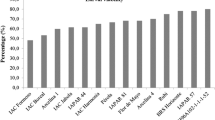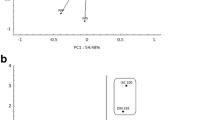Abstract
The effect of 14 soybean genotypes (Sahar, Sari, Williams, Tellar, Hill, Clark, Tms, Dpx, Zane, 032, 033, L17, Ks3494 and I27) on life history and fecundity of two-spotted spider mite (TSSM), Tetranychus urticae Koch, was investigated. All experiments were conducted at 28 ± 1°C, 65 ± 5% r.h. and a photoperiod of L16:D8 h. The highest development time was 8.41 and 8.78 days for male and female on I27, and the lowest value of this period was obtained on Sahar and Ks3494 for male and female, respectively (7.11 and 7.60 days, respectively). The TSSM fecundity varied from 33.62 to 153.82 eggs per female, which was minimum on 032 and maximum on L17. The comparison of TSSM biological parameters on different soybean genotypes and cluster analysis of these parameters demonstrated that Ks3494, 032, Dpx and Sahar were the most resistant genotypes to this pest. An antibiosis process could be, at least in part, the cause of this variation. Knowledge of the extent of susceptibility or resistance of genotypes and biology of a pest on a crop are fundamental components of integrated pest management (IPM) programs for any crop. Implication of these observations in the control of TSSM on soybean is discussed.
Similar content being viewed by others
References
Alston DG, Thomson SV (2004) Effects of fungicide residues on the survival, fecundity, and predation of the mites Tetranychus urticae (Acari: Tetranychidae) and Galendromus occidentalis (Acari: Phytoseiidae). J Econ Entomol 97:950–956. doi:10.1603/0022-0493(2004)097[0950:EOFROT]2.0.CO;2
Bong CFJ, Sikorowski PP, Davis FM (1991) Effects of a resistant maize genotype and cytoplasmic polyhedrosis virus on growth and development of the corn earworm (Lepidoptera: Noctuidae). Environ Entomol 20:1200–1206
Bounfour M, Tanigoshi LK (2001) Effect of temperature on development and demographic parameters of Tetranychus urticae and Eotetranychus carpini borealis (Acari: Tetranychidae). Ann Entomol Soc Am 94:400–404. doi:10.1603/0013-8746(2001)094[0400:EOTODA]2.0.CO;2
Carey JR, Bradley JW (1982) Developmental rates, vital schedules, sex ratios and life tables for Tetranychus urticae, T. turkestani and T. pacificus (Acarina: Tetranychidae) on cotton. Acarologia 23:333–345
Cedola CV, Sanchez NE (2003) Effect of tomato pubescence on development, survival and fecundity of Tetranychus urticae Koch and Neoseiulus californicus (McGregor) (Acari: Tetranychidae: Phytoseiidae). Acarologia 43:255–260
Eischen F, Dietz A (1987) Growth and survival of Galleria mellonella (Lepidoptera: Pyralidae) larva fed diets containing honey bee-collected plant resins. Ann Entomol Soc Am 80:74–77
Elden TC (1997) Influence of soybean lines isogenic for pubescence type on two-spotted spider mite (Acarina: Tetranychidae) development and feeding damage. J Entomol Sci 32:296–302
Gimenez-Ferrer RM, Erb WA, Bishop BL, Scheerens JC (1994) Host–pest relationship between the two spotted spider mite and strawberry cultivars with differing levels of resistance. J Econ Entomol 87:168–175
Hagley EAC, Barber DR (1992) Effect of food sources on the longevity and fecundity of Pholetesor ornigis (Weed) (Hymenoptera: Braconidae). Can Entomol 124:341–346
Hare JD, Andreadis TG (1983) Variation in the susceptibility of Leptinotarsa decemlineata (Coleoptera: Chrysomelidae) when reared on different host plants to the fungal pathogen, Beauvaria bassiana, in the field and laboratory. Environ Entomol 12:1892–1897
Hentz M, Nuessly G (2004) Development, longevity, and fecundity of Sipha flava (Homoptera: Aphididae) feeding on Sorghum bicolor. Environ Entomol 33:546–553
Huffaker CB, van de Vrie M, McMurty JA (1969) The ecology of tetranychid mites and their natural control. Annu Rev Entomol 14:125–147. doi:10.1146/annurev.en.14.010169.001013
James DG, Price TS (2002) Fecundity in two-spotted spider mite (Acari: Tetranychidae) is increased by direct and systemic exposure to imidacloprid. J Econ Entomol 95:729–732
Jyoti JL, Shelton AM, Earle ED (2001) Identifying sources and mechanisms of resistance in crucifers for control of cabbage maggot (Diptera: Anthomyiidae). J Econ Entomol 94:942–949
Kogan M, Ortman EF (1978) Antixenosis—a new term proposed to replace painter’s ‘non-preference’ modality of resistance. Bull Entomol Soc Am 24:175–176
Li Y, Hill CB, Hartman GL (2004) Effect of three resistant soybean genotype on the fecundity, mortality, and maturation of soybean aphid (Homoptera: Aphididae). J Econ Entomol 97:1106–1111. doi:10.1603/0022-0493(2004)097[1106:EOTRSG]2.0.CO;2
Lorenzen JH, Balbyshev NF, Lafta AM, Casper H, Tian X, Sagredo B (2001) Resistant potato selections contain leptine and inhibit development of the colorado potato beetle (Coleoptera: Chrysomelidae). J Econ Entomol 94:1260–1267
Luczynski A, Islam MB, Raworth DA, Chan CK (1990) Chemical and morphological factors of resistance against the two spotted spider mite in beach strawberry. J Econ Entomol 83:564–569
Martinez-Ferrer MT, Jacas JA, Piolles-Moles JL, Aucejo-Romero S (2006) Approaches for sampling the two spotted spider mite (Acari: Tetranychidae) on clementines in Spain. J Econ Entomol 99:1490–1499
Naher N, Islam T, Haque MM, Parween S (2006) Effect of native plant and IGRs on the development of Tetranychus urticae Koch (Acari: Tetranychidae). Univ J Zool Rajshahi Univ 25:19–22
Ofomata VC, Overholt WA, Lux SA, Huis AV, Egwuatu RI (2000) Comparative studies on the fecundity, egg survival, larval feeding, and development of Chilo orichalcociliellus (Lepidoptera: Crambidae) on five grasses. Ann Entomol Soc Am 93:492–499. doi:10.1603/0013-8746(2000)093[0492:CSOTFE]2.0.CO;2
Painter RH (1951) Insect resistance in crop plants. Macmillan, New York
Praslicka J, Huszar J (2004) Influence of temperature and host plants on the development and fecundity of spider mite Tetranychus urticae (Acari: Tetranychidae). Plant Prot Sci 4:141–144
Rajakumar E, Hugar PS, Patil BV (2005) Biology of red spider mite, Tetranychus urticae Koch (Acari: Tetranychidae) on jasmine. Karnataka J Agric Sci 18:147–149
Sabelis MW (1981) Biological control of two-spotted spider mites using phytoseiid predators Part I. Agriculture Research Reports 910. Pudoc, Wageningen
Saeidi Z, Mallik B (2006) In vitro screening of 67 Lycopersicon accessions/cultivars for resistance to two-spotted spider mite. J Biol Sci 6:847–853
SAS Institute (2003) GLM: a guide to statistical and data analysis, version 9.1. SAS Institute, Cary
Sedaratian A, Fathipour Y, Moharramipour S, Talebi AA (2008) Effect of different soybean varieties on bionomics of Tetranychus urticae (Acari: Tetranychidae). Mun Ent Zool 3:716–730
Shih CT, Poe SL, Cromroy HL (1976) Biology, life table and intrinsic rate of increase of Tetranychus urticae. Ann Entomol Soc Am 69:362–364
SPSS (2004) SPSS base 13.0 User’s guide. SPSS, Chicago
Stoner KA, Shelton AM (1988) Role of nonpreference in the resistance of cabbage varieties to the onion thrips (Thysanoptera: Thripidae). J Econ Entomol 81:1062–1067
Uckan F, Ergin E (2002) Effect of host diet on the immature developmental time, fecundity, sex ratio, adult longevity, and body size of Apanteles galleriae (Hymenoptera: Braconidae). Environ Entomol 13:168–171
van Lenteren JC, Noldus LPJJ (1990) Whitefly–plant relationship: behavioral and biological aspects. In: Gerling D (ed) Whitefly: their bionomics, pest status and management. Intercept, Andover, pp 47–89
Wilde G, Thomas W, Hall H (1991) Plant resistance to two spotted spider mite (Acari: Tetranychidae) in raspberry cultivars. J Econ Entomol 84:251–255
Wilson LJ (1994) Plant quality effect on life history parameters of the two-spotted spider mite (Acari: Tetranychidae) on cotton. J Econ Entomol 87:1665–1673
Acknowledgment
This research was partly supported by a grant form the Center of Excellence for Integrated Pests and Diseases Management of Oil Crops of Iran, which is greatly appreciated.
Author information
Authors and Affiliations
Corresponding author
Additional information
Communicated by C. Cutler.
Rights and permissions
About this article
Cite this article
Sedaratian, A., Fathipour, Y. & Moharramipour, S. Evaluation of resistance in 14 soybean genotypes to Tetranychus urticae (Acari: Tetranychidae). J Pest Sci 82, 163–170 (2009). https://doi.org/10.1007/s10340-008-0235-8
Received:
Revised:
Accepted:
Published:
Issue Date:
DOI: https://doi.org/10.1007/s10340-008-0235-8




